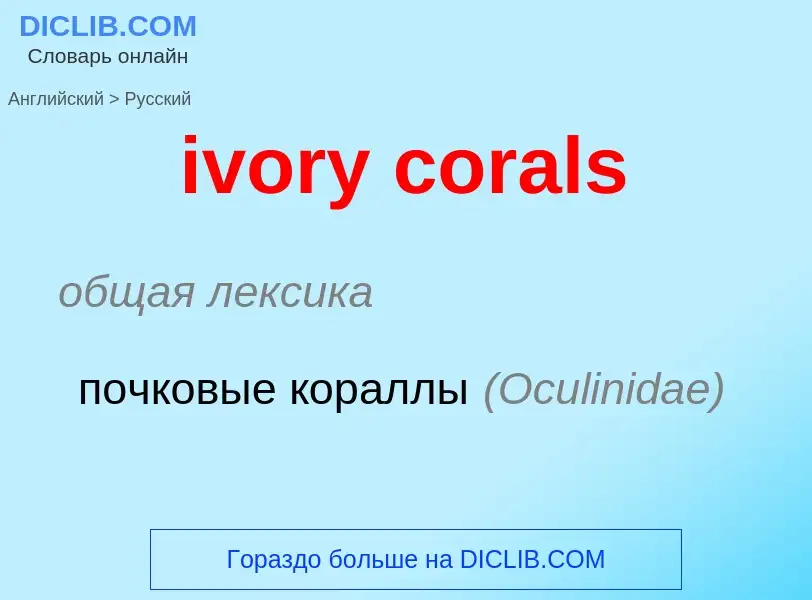Traducción y análisis de palabras por inteligencia artificial
En esta página puede obtener un análisis detallado de una palabra o frase, producido utilizando la mejor tecnología de inteligencia artificial hasta la fecha:
- cómo se usa la palabra
- frecuencia de uso
- se utiliza con más frecuencia en el habla oral o escrita
- opciones de traducción
- ejemplos de uso (varias frases con traducción)
- etimología
ivory corals - traducción al ruso
общая лексика
почковые кораллы (Oculinidae)
общая лексика
слоновая кость
Wikipedia

Scleractinia, also called stony corals or hard corals, are marine animals in the phylum Cnidaria that build themselves a hard skeleton. The individual animals are known as polyps and have a cylindrical body crowned by an oral disc in which a mouth is fringed with tentacles. Although some species are solitary, most are colonial. The founding polyp settles and starts to secrete calcium carbonate to protect its soft body. Solitary corals can be as much as 25 cm (10 in) across but in colonial species the polyps are usually only a few millimetres in diameter. These polyps reproduce asexually by budding, but remain attached to each other, forming a multi-polyp colony of clones with a common skeleton, which may be up to several metres in diameter or height according to species.
The shape and appearance of each coral colony depends not only on the species, but also on its location, depth, the amount of water movement and other factors. Many shallow-water corals contain symbiont unicellular organisms known as zooxanthellae within their tissues. These give their colour to the coral which thus may vary in hue depending on what species of symbiont it contains. Stony corals are closely related to sea anemones, and like them are armed with stinging cells known as cnidocytes. Corals reproduce both sexually and asexually. Most species release gametes into the sea where fertilisation takes place, and the planula larvae drift as part of the plankton, but a few species brood their eggs. Asexual reproduction is mostly by fragmentation, when part of a colony becomes detached and reattaches elsewhere.
Stony corals occur in all the world's oceans. Much of the framework of modern coral reefs is formed by scleractinians. Reef-building or hermatypic corals are mostly colonial; most of these are zooxanthellate and are found in the shallow waters into which sunlight penetrates. Other corals that do not form reefs may be solitary or colonial; some of these occur at abyssal depths where no light reaches.
Stony corals first appeared in the Middle Triassic, but their relationship to the tabulate and rugose corals of the Paleozoic is currently unresolved. In modern times stony corals numbers are expected to decline due to the effects of global warming and ocean acidification.


 (16744305176).jpg?width=200)
![''[[Diploria labyrinthiformis]]'', a [[brain coral]] ''[[Diploria labyrinthiformis]]'', a [[brain coral]]](https://commons.wikimedia.org/wiki/Special:FilePath/Brain coral.jpg?width=200)

![Hard coral ''[[Favites]]'' extends its polyps at night to feed Hard coral ''[[Favites]]'' extends its polyps at night to feed](https://commons.wikimedia.org/wiki/Special:FilePath/Favites flexuosa.jpg?width=200)
![''[[Montastraea annularis]]'' can be fragmented to form new colonies. ''[[Montastraea annularis]]'' can be fragmented to form new colonies.](https://commons.wikimedia.org/wiki/Special:FilePath/Montastraea annularis Molasses reef FL.jpg?width=200)
![[[Palaeozoic]] [[rugose corals]] with calcite skeletons, like this ''[[Grewingkia canadensis]]'', are doubtfully ancestors of the Scleractinia. [[Palaeozoic]] [[rugose corals]] with calcite skeletons, like this ''[[Grewingkia canadensis]]'', are doubtfully ancestors of the Scleractinia.](https://commons.wikimedia.org/wiki/Special:FilePath/RugosaOrdovician.jpg?width=200)
![50px]] Material was copied from this source, which is available under a [https://creativecommons.org/licenses/by/4.0/ Creative Commons Attribution 4.0 International License].</ref> 50px]] Material was copied from this source, which is available under a [https://creativecommons.org/licenses/by/4.0/ Creative Commons Attribution 4.0 International License].</ref>](https://commons.wikimedia.org/wiki/Special:FilePath/Settlement and early life stages of scleractinian corals.png?width=200)

![Cylindrical ivory casket, Siculo-Arabic, [[Hunt Museum]]. Cylindrical ivory casket, Siculo-Arabic, [[Hunt Museum]].](https://commons.wikimedia.org/wiki/Special:FilePath/Cylindrical Ivory Casket.jpg?width=200)
![An ivory [[tabernacle]] featuring the Madonna of Caress, France An ivory [[tabernacle]] featuring the Madonna of Caress, France](https://commons.wikimedia.org/wiki/Special:FilePath/Ivory tabernacle Louvre OA2587.jpg?width=200)

![A depiction of the [[Blessed Virgin Mary]] and the [[Child Jesus]] crafted in elephant ivory A depiction of the [[Blessed Virgin Mary]] and the [[Child Jesus]] crafted in elephant ivory](https://commons.wikimedia.org/wiki/Special:FilePath/Vierge a l'Enfant debout.jpg?width=200)
![The Bull Leaper, an ivory figurine from the palace of [[Knossos]], [[Crete]], 1500 BC The Bull Leaper, an ivory figurine from the palace of [[Knossos]], [[Crete]], 1500 BC](https://commons.wikimedia.org/wiki/Special:FilePath/The Bull Leaper Knossos 1500BC.jpg?width=200)
![pyxis]] with griffins attacking stags. Late 15th century BC pyxis]] with griffins attacking stags. Late 15th century BC](https://commons.wikimedia.org/wiki/Special:FilePath/AGMA Ivory Pyxis with Griffins Attacking Stags.jpg?width=200)
![A piece of carved ivory from the Pushkin Museum representing [[Christ]] blessing Emperor [[Constantine VII]]. Mid 10th century AD A piece of carved ivory from the Pushkin Museum representing [[Christ]] blessing Emperor [[Constantine VII]]. Mid 10th century AD](https://commons.wikimedia.org/wiki/Special:FilePath/Porphyrogenetus.jpg?width=200)
![Ivory cover of the [[Codex Aureus of Lorsch]], c. 810, [[Carolingian dynasty]], [[Victoria and Albert Museum]] Ivory cover of the [[Codex Aureus of Lorsch]], c. 810, [[Carolingian dynasty]], [[Victoria and Albert Museum]]](https://commons.wikimedia.org/wiki/Special:FilePath/Ivory cover of the Lorsch Gospels, c. 810, Carolingian, Victoria and Albert Museum.jpg?width=200)
![[[Pig]] tusks [[Pig]] tusks](https://commons.wikimedia.org/wiki/Special:FilePath/BigUnTusks6184w.jpg?width=200)

![''Battle of Hannibal and Scipio (Alexander's victory over Poros)'', by [[Ignaz Elhafen]], c. 1700, [[Warsaw Royal Castle]] ''Battle of Hannibal and Scipio (Alexander's victory over Poros)'', by [[Ignaz Elhafen]], c. 1700, [[Warsaw Royal Castle]]](https://commons.wikimedia.org/wiki/Special:FilePath/Elhafen Battle of Hannibal and Scipio.jpg?width=200)
![Section through the ivory tusk of a [[mammoth]] Section through the ivory tusk of a [[mammoth]]](https://commons.wikimedia.org/wiki/Special:FilePath/Mammoth ivory hg.jpg?width=200)

.jpg?width=200)
![The ''[[Morgan Casket]]'', an 11th-century ivory casket attributed to Southern Italy, currently in the collection of the [[Metropolitan Museum of Art]] The ''[[Morgan Casket]]'', an 11th-century ivory casket attributed to Southern Italy, currently in the collection of the [[Metropolitan Museum of Art]]](https://commons.wikimedia.org/wiki/Special:FilePath/Morgan Casket MET DP100742.jpg?width=200)
![A cubical ivory bead or game piece from the collections of the [[Hunt Museum]] A cubical ivory bead or game piece from the collections of the [[Hunt Museum]]](https://commons.wikimedia.org/wiki/Special:FilePath/Ivory bead A.jpg?width=200)
![Murshidabad]], [[India]] Murshidabad]], [[India]]](https://commons.wikimedia.org/wiki/Special:FilePath/Royal Peacock Barge LACMA M.82.154.jpg?width=200)
![Ivory workers in [[Calcutta]], c. 1903 Ivory workers in [[Calcutta]], c. 1903](https://commons.wikimedia.org/wiki/Special:FilePath/Ivory workers in Calcutta (c. 1903).jpg?width=200)
